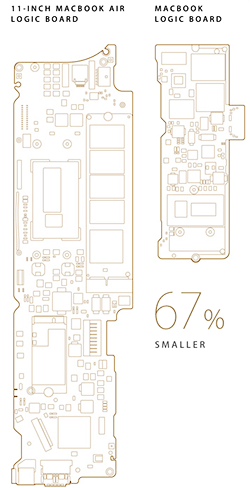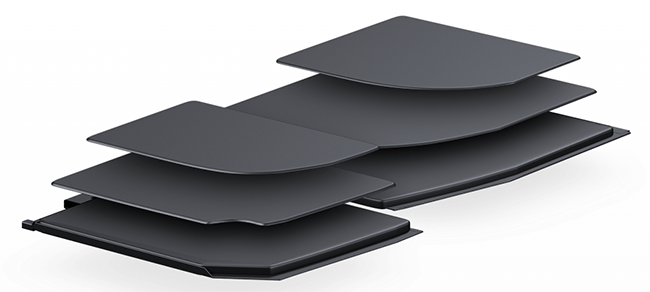The good looks of the new 12 inch MacBook got most of the attention when the light, thin laptop was unveiled. But the most important components were hidden inside the case and may be the important changes in the coming generations of laptops.
In fact, the real story is what was left out of the case. Internal components have been disappearing from laptops, especially the ultra-light, ultra-thin competitors. The optical disc drive was eliminated and traditional storage disks were replaced with solid-state drives.
The most dramatic change in the MacBook are the batteries–yes, not battery. As shown in the pictures above, (( All pictures are from http://www.apple.com/macbook/design/ )) the power supply consists of several odd-shaped components. Until around 2000, batteries–first nickel-cadmium, then lithium–had to be made as rectangular prisms. As lithium polymer (LiPo) cells came along, it became feasible to make the battery follow other shapes.
But the MacBook is dramatically different. Apple has been receiving patents back to 2012 that allow it to group thin LiPo cells in stacks. This is what makes the Mac Pro battery layout possible. The battery components virtually fill the insides of the case, fitting into areas designed for them in the case of milled aluminum.

The batteries fit into the fancy sockets–two on each side, two more in the two spaces just below the motherboard. The batteries fill nearly all the space and they, along with the glass of the display, generate most of the laptop’s minimal weight. Apple has not specified the MacBook’s battery storage capacity, but is promising nine hours of running time.
 The motherboard is stunningly tiny, even in comparison to the MacBook Air. Until iFixit gets a chance to tear one down, we won’t know how Apple has revised the choice and design of components to achieve this miniaturization, but it is impressive.
The motherboard is stunningly tiny, even in comparison to the MacBook Air. Until iFixit gets a chance to tear one down, we won’t know how Apple has revised the choice and design of components to achieve this miniaturization, but it is impressive.
The shrinkage of the Mac, especially its thinness, has forced some other critical design changes. The most noticed, of course, is the replacement of the MagSafe power connections and USB-B ports with a single USB-C. And there is no fan.
Changes were also forced in the design of the trackpad and the keyboard and, in both cases, Apple claims a much better as well as thinner design. (I was impressed by both during a brief try, but I’m going to reserve my judgment until I have a chance to work with the MacBook.) The ForceTouch uses four pressure sensors and haptic feedback to provide the sense of a click from a pad that does not move at all. The Air trackpad moves on links at the top of the rectangle, causing the response to be uneven over the course of the pad.
The keyboard doesn’t quite eliminate movement, but it replaced the “scissors” system used in general on laptop keyboards with what Apple calls a “butterfly” mechanism. (( I like the design but hate the name. The butterfly keyboard name belongs forever to the opening keyboard of the IBM ThinkPad 701, the invention of the late John Karidis. )) The goal, Apple claims, is keys that respond equally to pressing any where on them. The keys are also bigger than those on the Air and feel very good even though their vertical travel is very short.
Thin and light laptops are, of course, making their way through the Windows market too, but Apple seems, once again, to have jumped out in front of the market. The combined goal of very light weight and very long battery life seems to be a way to encourage owners to use the MacBook as a sort of “super tablet”. Not everyone will like it and, for now, the Air and other MacBooks are all staying in the market. But I think it will shake the design of the field up more than the Air.

As beautiful and a master piece of hardware the new Macbook might be, it will be the Future of computer only if it run Chrome OS or or something similar from Apple
“Apple has not specified the MacBook’s battery storage capacity”
On their website Apple says the new MacBook has a 39.7 watt battery. This compares to 38W for the 11″ MBA and 54W for the 13″. The new MacBook only has a 29W power adapter which makes me think it will take longer to charge than an Air, which uses a 45W adapter.
You’re right; I found those specs now, though I’m not sure if they were up when I wrote.
I don’t think we’ll know until we have chance to try how long it will take to charge the MacBook or, for that matter, how much power the Air took in, rather than the capacity of the charger. The listed spec is about the same range as the 13″ Air, which hasn’t bothered me.